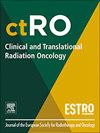Symptomatic posttreatment edema after stereotactic radiotherapy (SRS/FSRS) for intracranial meningiomas: patterns and predictive factors
IF 2.7
3区 医学
Q3 ONCOLOGY
引用次数: 0
Abstract
Background
Symptomatic posttreatment edema (SPTE) is a complication that may develop after radiotherapy for intracranial meningiomas. Our study aims at reviewing rates of SPTE in a large cohort of a single institution and identifying possible predictive factors.
Methods
We retrospectively analyzed data of 293 patients with 304 intracranial meningiomas irradiated at our institution between 2005 and 2018. We evaluated rates of SPTE and investigated numerous factors by univariate and multivariate analysis. Kaplan Meier analysis was used for estimation of actuarial local control and overall survival.
Results
Median age was 60 years. Meningiomas were treated with fractionated stereotactic radiation therapy (70 %), single fraction stereotactic radiosurgery (24 %) or fractionated stereotactic radiosurgery (6 %). Median imaging follow-up was 60 months, actuarial 10 year local control rate for patients with grade 1 meningiomas who received radiotherapy as definitive treatment was 99 %. Local control at 5 years was 94 % for grade 1 meningioma, 57 % and 53 % for grade 2 and 3 respectively. Sixteen patients (5.5 %) developed SPTE, median time to onset was 3 months (range 1–26 months). the higher rates of SPTE observed were in midline (13 %) and convexity (9 %), compared to skull base tumors (2 %). On univariate analysis, age > 60 years (p > 0.03), pretreatment peritumoral edema (p = 0.014), medline location (p = 0.018), tumor size > 30 mm (p = 0.015) and grade 2 histology (p = 0.03) were predictive of SPTE. On multivariate analysis, only tumor location and size remained statistically significant.
Conclusions
Based on our results, patients at high risk of SPTE can be identified based on patient and tumor characteristics. The best treatment technique in high risk patients is yet to be defined.
颅内脑膜瘤立体定向放疗(SRS/FSRS)后的症状性水肿:模式和预测因素
背景:症状性治疗后水肿(SPTE)是颅内脑膜瘤放疗后可能出现的并发症。我们的研究旨在回顾单一机构的大型队列中SPTE的发生率,并确定可能的预测因素。方法回顾性分析我院2005年至2018年收治的304例颅内脑膜瘤患者293例的资料。我们评估了SPTE的发生率,并通过单因素和多因素分析调查了许多因素。Kaplan Meier分析用于估计精算局部控制和总生存期。结果中位年龄为60岁。脑膜瘤采用分次立体定向放射治疗(70%)、单次立体定向放射治疗(24%)或分次立体定向放射治疗(6%)。影像学随访中位数为60个月,精算10年局部控制率为99%,放疗为最终治疗的1级脑膜瘤患者。5年局部控制率1级脑膜瘤为94%,2级和3级脑膜瘤分别为57%和53%。16例(5.5%)发生SPTE,中位发病时间为3个月(范围1-26个月)。与颅底肿瘤(2%)相比,中线肿瘤(13%)和凸部肿瘤(9%)的SPTE发生率较高。单变量分析,年龄>;60年(p >;0.03)、预处理肿瘤周围水肿(p = 0.014)、中线位置(p = 0.018)、肿瘤大小>;30mm (p = 0.015)和2级组织学(p = 0.03)是SPTE的预测指标。在多变量分析中,只有肿瘤的位置和大小具有统计学意义。结论根据我们的研究结果,可以根据患者和肿瘤特征来识别SPTE的高危患者。高风险患者的最佳治疗技术尚未确定。
本文章由计算机程序翻译,如有差异,请以英文原文为准。
求助全文
约1分钟内获得全文
求助全文
来源期刊

Clinical and Translational Radiation Oncology
Medicine-Radiology, Nuclear Medicine and Imaging
CiteScore
5.30
自引率
3.20%
发文量
114
审稿时长
40 days
 求助内容:
求助内容: 应助结果提醒方式:
应助结果提醒方式:


